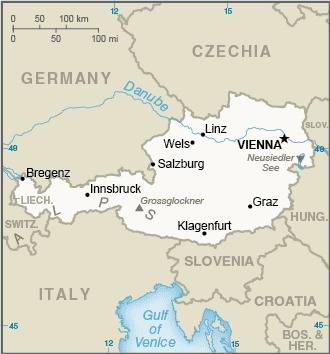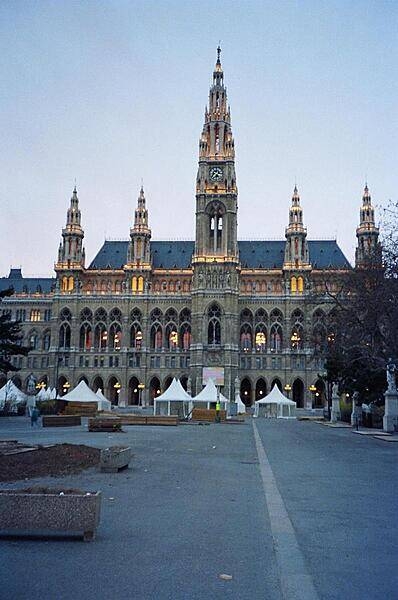56 Austria

Three equal horizontal bands of red (top), white, and red. The flag design is certainly one of the oldest – if not the oldest – national banners in the world. According to tradition, in 1191, following a fierce battle in the Third Crusade, Duke Leopold V of Austria’s white tunic became completely blood-spattered. Upon removal of his wide belt or sash, a white band was revealed. The red-white-red color combination was subsequently adopted as his banner.
Flag courtesy of the CIA World Factbook

Map courtesy of the CIA World Factbook

The Rathaus (City Hall) in Vienna is the seat of the mayor and the city council. It was built in the Gothic style between 1872-83.
Photo courtesy of the CIA World Factbook
Government
According to Britannica, under the constitution of 1920, with minor changes made in 1929, Austria is a “democratic republic: its law derives from the people.” A federal republic, Austria consists of nine self-governing Länder (states): Burgenland, Kärnten (Carinthia), Niederösterreich (Lower Austria), Oberösterreich (Upper Austria), Salzburg, Steiermark (Styria), Tirol, Vorarlberg, and Wien (Vienna). The states have considerable autonomy.
In 1934 the Austrian constitution was replaced by an authoritarian regime under Chancellors Engelbert Dollfuss and Kurt von Schuschnigg. This in turn was eliminated by Adolf Hitler after Nazi Germany annexed Austria in 1938 (see Anschluss). With the liberation of Austria in 1945, the constitution of 1929 was revived and subsequently became the foundation stone of constitutional and political life in the “Second Republic.”
The federal president and the cabinet share executive authority. The president, elected by popular vote for a term of six years, acts as head of state and calls parliament into session. The president can dissolve parliament during the four-year legislative period, unless it dissolves itself by law, and can order new elections. The president also acts as commander in chief of the armed forces.
The head of government is the federal chancellor. The president appoints the chancellor, although the parliamentary majority actually determines the president’s choice. The chancellor nominates the other cabinet members, who also are officially appointed by the president. The cabinet cannot remain in office if it and its members do not enjoy the confidence of the majority of the National Council (one of the houses of parliament).
The parliament, known as the Federal Assembly, consists of two houses: the National Council (Nationalrat) and the Federal Council (Bundesrat). The National Council, wielding the primary legislative power, is elected by all citizens who are at least 16 years of age, and every citizen over age 26 is eligible to run for office. The distribution of seats in the National Council is based on a system of proportional representation. The members of the Federal Council represent the states. The assemblies, or diets, of the states elect the members by a proportional system based on the population of the state.
The legislative process originates in the National Council. Each bill, except for the budget, which is the sole prerogative of the National Council, must be approved by the Federal Council. The National Council, however, can override a Federal Council veto by a simple majority vote.
Each of the nine states is administered by a government headed by a governor (Landeshauptmann); the governor is elected by the legislative diet, which in turn is elected by general ballot. The local municipalities each elect a mayor and a city council. Vienna is a unique case: as it is both a municipality and a state, its mayor functions as the governor.
The administration of justice is independent of Austrian legislative and administrative authorities. Judges are not subject to any government influence: they are appointed by the cabinet upon nomination by judicial panels and can be neither dismissed nor transferred without the panels’ agreement.
Austria has three high courts: one sitting as the highest body of appeal in civil and criminal matters; a top administrative court to which citizens aggrieved by administrative decisions can appeal; and a constitutional court that decides on all constitutional matters, civil rights, and election disputes.
Supreme Civil Aviation Authority
The Supreme Civil Aviation Authority is part of the Austrian Federal Ministry for Climate Action, Environment, Energy, Mobility, Innovation and Technology (BMK) and acts as higher and partly as oversight authority for further aviation authorities (like Austro Control, Aero Club, Federal Provinces and districts). Main task of the Supreme Civil Aviation Authority are the regulation of the legislative basis on national level, the representation of Austria at the EU and at international organizations as well as the negotiation of bilateral aviation agreements. Based on the effective legal provisions aviation regulatory permissions, e.g. commercial transport, aerodromes, air navigation service providers and aerodrome fees are granted. Furthermore the Supreme Civil Aviation Authority executes oversight of organizations, especially aerodromes, aerospace companies, air navigation service and providers as well as quality control in the sense of safety in aviation.
Airspace
SkyVector – Google Maps – ADS-B Exchange
ICAO countries publish an Aeronautical Information Publication (AIP). This document is divided into three parts: General (GEN), En Route (ENR) and Aerodromes (AD). ENR 1.4 details the types of airspace classes they chose to adopt from classes A through G.
Austro Control
Austro Control GmbH has been responsible for air traffic control and air safety in Austrian airspace since 1 January 1994. There are as many as 3,000 controlled flights in Austrian airspace on some days, often at altitudes of 10,000 meters or more. Aided by state-of-the-art technology, the air traffic controllers of Austro Control bring planes into the right airways and ensure that they keep their distance from others.
Austro Control publishes a poster on airspace structure and has more information available to the public.

Drone Regulations
Dronespace is the Austro Control drone portal – the central point of contact for all questions relating to unmanned aircraft – from registration to the drone driver’s license to the drone flight.
Regulation (EU) 2019/947 uniformly regulates flying with drones throughout the EU.
Drone License – The “drone pilot’s license” is mandatory for all drone pilots who want to fly with drones in the “open” category with a weight of more than 250 g (A1, A2 and A3).
There is an online course that is provided free of charge by Austro Control.
Advanced Air Mobility (AAM) Regulations & Policies
Bilateral agreements facilitate the reciprocal airworthiness certification of civil aeronautical products imported/exported between two signatory countries. A Bilateral Airworthiness Agreement (BAA) or Bilateral Aviation Safety Agreement (BASA) with Implementation Procedures for Airworthiness (IPA) provides for airworthiness technical cooperation between the FAA and its counterpart civil aviation authorities.
Reciprocal acceptance of aviation safety-related approvals and services with the European Union Aviation Safety Agency (EASA) and Member States of the European Union are primarily governed by the U.S. – European Union Safety Agreement.
Advanced Air Mobility (AAM) News
2025
Video courtesy of Advanced Air Mobility Institute from the January 2025 Global AAM Forum. Complete session for Day 1 of this Forum is available on the Advanced Air Mobility Institute YouTube Channel
Short Essay Questions
Scenario-Based Question
You have been hired by a Drone Startup Company. Your boss has immediately assigned this job to you.
They need you to prepare a one-page memo detailing the legalities of using a drone over City Hall in Vienna, pictured above.
They need you to mention any national laws and local ordinances.
They specifically want to know what airspace (insert pictures) you will be operating in and whether or not you need an airspace authorization.
Does it matter whether or not you are a citizen of the country?
Lastly, there is a bonus for you if, as you scroll through this chapter, you find any typos or broken links!
Short Essay Questions
- What are the drone categories?
- How is registration addressed?
- How is remote ID addressed?
- What are the model aircraft rules?
- What are the commercial drone rules?
- Are there waivers or exemptions to the rules? If so, for what?
- Would you share a link to an interactive airspace map?
- How is BVLOS addressed?
- How can you fly drones at night?
- How can you fly drones over people?
- Where do you find drone NOTAMs?
- What are the rules for drone maintenance?
- What are the rules for an SMS program?
- What are some unique rules not mentioned above?
- What are the C-UAS rules?
- What are the AAM rules?

